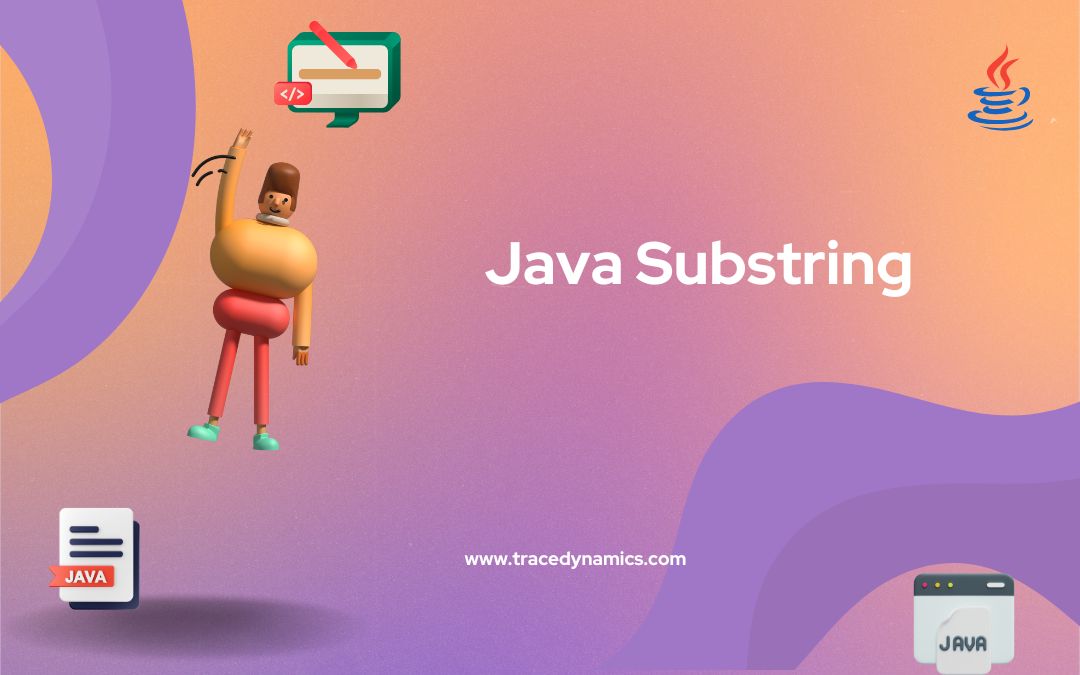In the world of Java programming, string manipulation is key, and the Java substring method is crucial for robust application development.
Unveiling the Mystery: Demystifying substring
The substring method in Java’s String class offers two variants:
- substring(int beginIndex): Extracts a substring from the specified
beginIndexto the end of the string. - substring(int beginIndex, int endIndex): Allows precise extraction from
beginIndextoendIndex.
Exploring the Capabilities: Illuminating Examples
- Example: Extracting the First N Characters
String message = "Welcome to the world of Java!"; String firstFive = message.substring(0, 5); // "Welco" System.out.println(firstFive); - Example: Isolating a Specific Substring
String movieTitle = "The Shawshank Redemption"; String titlePart = movieTitle.substring(10, 19); // "Redemption" System.out.println(titlePart); - Example: Extracting Delimited Substrings
String list = "apple,banana,cherry"; String firstFruit = list.substring(0, list.indexOf(",")); // "apple" System.out.println(firstFruit); - Example: Building Dynamic Substrings
Java String name = "John Doe"; int age = 30; String greeting = "Hello, " + name.substring(0, name.indexOf(" ")) + "! You are " + age + " years old."; System.out.println(greeting);
This example extracts the first five characters (“Welco”) from the string.
This example isolates the substring “Redemption” from the movie title.
This code snippet retrieves the first fruit (“apple”) from a comma-separated list, utilizing the indexOf method to locate the delimiter.
This example dynamically constructs a greeting by extracting the first name using substring and concatenating it with other elements.
Beyond the Basics: Navigating the Complexities
As with any powerful tool, the substring method has its own intricacies:
- Index Out of Bounds: Accessing non-existent indexes throws IndexOutOfBoundsException. Always ensure valid indices.
- Empty Substrings: Extracting beyond the string length results in an empty string.
- Performance: Repeatedly extracting substrings can impact performance. Consider using StringBuilders for frequent manipulations.
Embracing the Power: Harnessing the Potential
By understanding the intricacies and versatile applications of the substring method, you can unlock its potential to:
- Parse and manipulate data: Extract specific information from strings, like usernames or product names.
- Validate user input: Ensure input fits within specific criteria by extracting relevant parts.
- Format and customize strings: Create dynamic greetings, build formatted messages, and personalize content.
Unveiling the Synergies: Combining substring with Other Methods
The true power of substring lies in its synergy with other string manipulation methods:
- charAt(int index): Extracts a single character at a specific index.
- indexOf(String str): Finds the first occurrence of a substring within the string.
- lastIndexOf(String str): Finds the last occurrence of a substring within the string.
- replace(String oldValue, String newValue): Replaces all occurrences of a substring with another.
Engaging Examples: Unveiling Hidden Potential
Explore the versatile applications of substring through practical examples:
- Example: Extracting Substrings Based on Delimiters
String names = "John,Mary,Peter"; String[] nameList = names.split(","); for (String name : nameList) { System.out.println(name); } - Example: Replacing Specific Substrings
String url = "https://www.example.com/products"; String newUrl = url.replace("/products", "/categories"); System.out.println(newUrl); - Example: Extracting and Formatting Specific Data
String priceString = "$12.50"; double price = Double.parseDouble(priceString.substring(1)); System.out.println(price); - Example: Building Dynamic Messages with Substrings
Java String firstName = "John"; String lastName = "Doe"; String greeting = "Hello, Mr. " + lastName.substring(0, 1) + ". " + firstName + ", how are you?"; System.out.println(greeting);
This code snippet utilizes split to split the string based on the comma delimiter and extracts each individual name using substring within the loop.
TThis example demonstrates how to replace the “/products” part of a URL with “/categories” using the replace method.
This code snippet extracts the price value (excluding the leading “$”) from a string using substring and converts it to a double using parseDouble.
This example dynamically constructs a personalized greeting by extracting the first letter of the last name and combining it with other elements using substring.
Beyond the Horizons: Exploring Advanced Applications
Discover advanced uses of substring, such as building custom string tokenizers, text normalization, and creating search algorithms.
Conclusion: Mastering the Art of String Substrings
Deepening your understanding of substring and its combinations with other methods enhances your string manipulation skills in Java.
Frequently Asked Questions
What is the substring method in Java?
The substring method in Java is used to extract a part of a string based on specified indices.
How do you use the substring method?
The substring method is used by specifying the start index and optionally the end index in the format string.substring(startIndex, endIndex).
What happens if the end index is omitted in substring?
If the end index is omitted, substring extracts the part of the string from the start index to the end of the string.
Does substring include the character at the end index?
No, the character at the end index is not included; substring stops extraction right before the end index.
Can substring handle negative indices?
No, substring in Java does not support negative indices and will throw an IndexOutOfBoundsException.
What exception can substring throw?
Substring can throw IndexOutOfBoundsException if the start or end indices are invalid.
How can substring be used with other string methods?
Substring can be combined with methods like indexOf to extract specific parts of a string dynamically.
Is substring case-sensitive?
Yes, the substring method is case-sensitive when extracting parts of a string.
Can substring modify the original string?
No, substring does not modify the original string; it returns a new string with the extracted part.
How is substring useful in data parsing?
Substring is useful in data parsing to extract and process specific segments of strings, such as parsing structured data.

